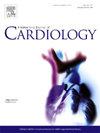The association between cardiovascular risk and physical performance in individuals with obesity: A cross-sectional study focusing on the 5× sit-to-stand test
IF 3.2
2区 医学
Q2 CARDIAC & CARDIOVASCULAR SYSTEMS
引用次数: 0
Abstract
Introduction
Although it is established that individuals with obesity are at increased risk of cardiovascular events, the relationship between cardiovascular risk and physical function in this population is still a topic of discussion. The objectives of the present study were: to check the association between cardiovascular risk and physical performance through physical-functional tests and to identify cutoff points for functional tests to be used for the definition of high cardiovascular risk.
Methods
A cross-sectional study included adults, both sexes, with obesity. Dual X-ray absorptiometry was used to assess body composition, Jamar® dynamometer to assess handgrip strength, and the sit-to-stand test to a chair with 5 repetitions and 60 s for physical performance analysis. The Framingham global risk score was used to determine cardiovascular risk.
Results
The sample consisted of 192 individuals with obesity, aged between 20 and 74 years (mean ± SD: 42.6 ± 12.7 years). The group with high cardiovascular risk presented worse values of handgrip strength and physical performance (p < 0.05). After adjusting for age, the 5× sit-to-stand test was associated (β = 0.21; OR = 1.24 [95 %CI = 1.05-1.45]; p = 0.007) with high cardiovascular risk, and the cutoff point of 16 s for performing the test was found to be discriminatory of high cardiovascular risk in obesity.
Conclusion
The findings indicate that clinical assessment tools, specifically those that assess the functionality of individuals with obesity, are related to an increased risk of cardiovascular events. The 5× sit-to-stand test showed good diagnostic accuracy in this context.
肥胖个体心血管风险与身体表现之间的关系:一项关注5×坐立试验的横断面研究。
虽然已经确定肥胖个体心血管事件的风险增加,但在这一人群中心血管风险与身体功能之间的关系仍然是一个讨论的话题。本研究的目的是:通过身体功能测试检查心血管风险与身体表现之间的关系,并确定用于定义心血管高风险的功能测试的截止点。方法:横断面研究包括成年人,男女,肥胖。双x射线吸收仪用于评估身体成分,Jamar®测力仪用于评估握力,并对椅子进行坐立测试,重复5次,60次 进行物理性能分析。Framingham全球风险评分用于确定心血管风险。结果:样本包括192名肥胖患者,年龄在20 ~ 74 岁之间(平均 ± SD: 42.6 ± 12.7 岁)。结论:研究结果表明,临床评估工具,特别是那些评估肥胖个体功能的工具,与心血管事件风险增加有关。在这种情况下,5×坐立试验显示出良好的诊断准确性。
本文章由计算机程序翻译,如有差异,请以英文原文为准。
求助全文
约1分钟内获得全文
求助全文
来源期刊

International journal of cardiology
医学-心血管系统
CiteScore
6.80
自引率
5.70%
发文量
758
审稿时长
44 days
期刊介绍:
The International Journal of Cardiology is devoted to cardiology in the broadest sense. Both basic research and clinical papers can be submitted. The journal serves the interest of both practicing clinicians and researchers.
In addition to original papers, we are launching a range of new manuscript types, including Consensus and Position Papers, Systematic Reviews, Meta-analyses, and Short communications. Case reports are no longer acceptable. Controversial techniques, issues on health policy and social medicine are discussed and serve as useful tools for encouraging debate.
 求助内容:
求助内容: 应助结果提醒方式:
应助结果提醒方式:


